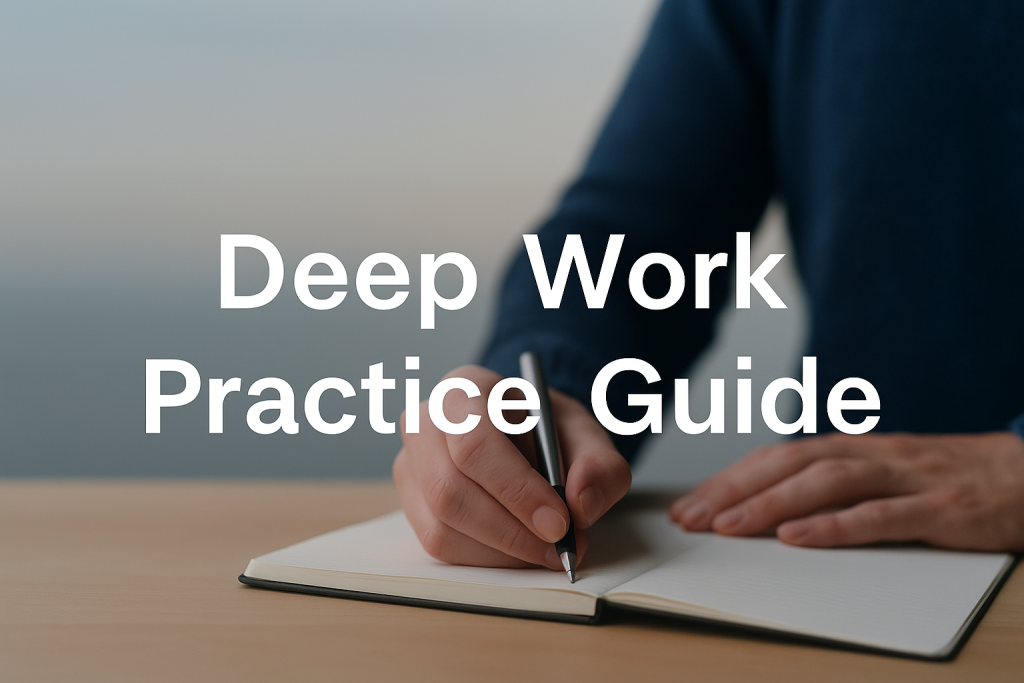Deep Work Practice Guide: How to Master Focus in a Distracted World
Train your brain to dive deep, eliminate distractions, and produce meaningful work
Feeling Busy but Getting Nothing Done?
You start the day with clear goals. But by evening, your mind is scattered, and your to-do list is barely touched. Emails, notifications, and small tasks eat away your time. You feel productive — but not fulfilled.
What’s missing? Often, it’s deep focus. In an age of endless distraction, doing meaningful work requires more than discipline — it requires a shift in how you approach time and attention.
In this Deep Work Practice Guide, we’ll explore what deep work really means, why it matters, and how you can build it into your daily routine — even in a noisy world.
—
What Is Deep Work?
Defined by Cal Newport
Coined by author and computer science professor Cal Newport, deep work is the ability to focus without distraction on cognitively demanding tasks. It’s the opposite of shallow work — like replying to emails or mindless multitasking.
Key Benefits of Deep Work
- Higher-quality output: When your brain is fully engaged, your work improves in clarity and creativity.
- Faster learning: Deep work strengthens mental pathways, helping you absorb and apply new information more efficiently.
- Career differentiation: In a distracted workforce, those who master focus stand out and solve harder problems.
—
Why Deep Work Is Hard — But Necessary
We’re Conditioned for Distraction
Phones, tabs, alerts — we’re surrounded by tools designed to fragment our attention. Shallow work feels easy and busy, making it more addictive than effortful, high-focus tasks.
Multitasking Weakens Focus
Switching tasks depletes cognitive resources. Even brief interruptions can create “attention residue,” making it harder to get back into flow.
Deep Work Is a Skill, Not a Mood
Waiting until you “feel focused” won’t work. Like fitness, deep focus is trained through deliberate practice, boundaries, and mental conditioning.
—
How to Build a Deep Work Routine
1. Schedule Deep Work Blocks
Choose 1–2 time blocks each day (ideally 60–90 minutes) for distraction-free focus. Treat these sessions like meetings — non-negotiable, protected time.
2. Design a Distraction-Free Environment
- Silence your phone or place it in another room
- Use website blockers (e.g., Freedom, Cold Turkey, or StayFocusd)
- Close all tabs unrelated to your task
- Work in full-screen mode or turn off Wi-Fi if possible
3. Choose One High-Impact Task
Don’t cram multiple items into a session. Focus on a single, meaningful task — whether it’s writing, coding, designing, or strategic thinking. Clarity supports depth.
—
Build Consistency, Not Perfection
4. Start Small and Scale Gradually
If 90 minutes feels daunting, start with 30. Increase over time as your mental stamina improves. Deep work is like weight training — consistency builds strength.
5. Track Your Focus
Use a journal, whiteboard, or focus app to log deep work hours. This visual feedback reinforces progress and helps identify peak productivity times.
6. Rest and Recover
Deep focus drains energy. Balance it with quality sleep, breaks, and downtime. The best deep workers protect their energy as fiercely as their time.
—
Deep Work in Different Environments
For Remote Workers
Use rituals to signal the start of deep work — like changing locations, using noise-canceling headphones, or turning off Slack. Let teammates know your schedule to avoid interruptions.
For Office Professionals
Block calendar slots as “busy.” Use office pods or quiet zones. Pair up with a “focus buddy” who helps keep you accountable and distraction-free.
For Creatives and Freelancers
Create a consistent workspace. Set a specific goal for each session. Use analog tools (like pen and paper) to reduce digital temptation.
—
Common Mistakes to Avoid
1. Trying to Multitask
Deep work requires full attention. Juggling tasks reduces depth and increases fatigue.
2. Overscheduling Yourself
Too many deep work sessions lead to burnout. Balance with shallow work, meetings, and recovery time.
3. Expecting Instant Flow
It can take 10–20 minutes to enter a state of focus. Don’t abandon your session too early. Stay with the task through initial discomfort.
—
Conclusion: Depth Creates Meaningful Work
Deep work is where your best ideas are born, your most important skills sharpen, and your highest-impact results happen. In a distracted world, cultivating this focus is more than a productivity hack — it’s a superpower.
Shallow work gets attention. Deep work gets results.
✨ Want to start now? Block off your next 60 minutes, silence distractions, and focus on a task that truly matters. Subscribe for weekly tools, templates, and focus rituals to build your deep work habit.
